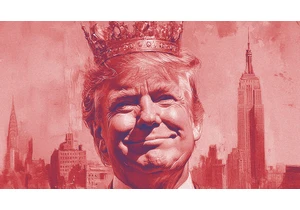Pinterest is making me hungry.
I’ve logged on to the site, as I often have since buying my house, in search of furniture. Pinterest’s recommendation systems have risen to the challenge, accurately clocking my recent saves of rugs and nightstands as signs I might be looking to furnish a bedroom.
Pinterest, though, wants to go beyond showing me more of the same. It wants to inspire, as CEO Bill Ready tells me in a recent conversation. The platform pushes me to consider not only fabric swatches but also outfits and travel destinations and other things I might like, for as long as I feel like scrolling. On this day, interspersed among the bed frames and side tables, the feed also served up churro cheesecake bars, lemon ricotta pasta, and something called Thai spaghetti salad.
Now I’m browsing recipes, each click sending positive reinforcement to the artificial intelligence systems the company is counting on to usher it into a new era. A few minutes later, my stomach starts to growl. I feel inspired . . . to order DoorDash. Furnishing my bedroom will have to wait.
As Ready will explain, what I’ve just experienced represents the core tension of the platform. Pinterest is designed to help me curate collections of beautiful and useful things. But the future of the business lies in getting me to buy them—without ever leaving Pinterest.
For most of the company’s life, that hasn’t been possible. Pins, as the company calls content, didn’t include real-time pricing and inventory information until 2018. The company makes its money through advertising; its e-commerce efforts have been slower to develop.
Fixing that is Ready’s job. He became Pinterest’s second-ever CEO in June 2022, when cofounder Ben Silbermann took the title of executive chairman after almost 13 years running the company. At the time, Pinterest’s stock had collapsed 78% from its February 2021 peak, and the service was shedding users, dropping from 478 million in March 2021 to 433 million 15 months later.
Payments and e-commerce have defined Ready’s career so far. He’s the former CEO of Braintree and Venmo, both owned by PayPal, and he joined Pinterest from Google, where he was the company’s president of commerce.
During his first year at Pinterest, Ready has been able to give investors much of what they want. Revenue rose 6% to $708 million in the second quarter, beating analysts’ expectations. Perhaps more impressively, the company’s monthly user base has grown more than 7% from when he took over a year ago, from 433 million to 465 million. As of September, Pinterest’s stock was up more than 45% under Ready’s tenure, outpacing the S&P 500, which grew about 18% over that same time. Although these numbers are promising, Pinterest’s primary publicly traded rival is growing more quickly. In the same quarter, Meta revenue hit $32 billion—an 11% increase over the last year—and its stock price was up more than 85% since the end of June 2022.

Ready faces new challenges as he enters his second year. The basic idea—to turn Pinterest into a premier daily shopping destination—is the same as it has been since Silbermann’s tenure. Ready has also promised to forsake what he sees as lower-quality engagement, pushing the site away from clickbait in an effort to make users feel good about the time they spend browsing. At the same time, Ready is facing a tumultuous moment in the history of the consumer internet. Regulatory threats to TikTok and the end of Twitter have created fresh opportunities for social networks, as has the rise of generative AI.
How will Ready seize the moment? He and I sat down in a colorfully decorated conference room at Pinterest’s San Francisco headquarters in late July to talk about his first year at the company, Pinterest’s commerce ambitions, and how to build a more positive social network.
This conversation has been edited for length and clarity.
Fast Company: How has the company evolved since you took over?
Bill Ready: One, we returned the platform to user growth after a period of decline. Engagement per user is deepening. Each user is getting more out of the platform, and more of what they want on the platform. So that’s been really good. We’ve focused on what users want from Pinterest that’s unique. It’s not an entertainment platform. Pinterest is more lean-forward, intent mode.
If you think about where Pinterest was versus where it is, Pinterest [had] solved for digital window-shopping—sort of walking the bazaar. But the issue was that all the stores were closed. You couldn’t take action on the stuff that you would find. As we’ve been bringing in that ability to take action for users, we’re finding that it solves a big pain point.
FC: You had a long career in payments and commerce before you came to Pinterest. What themes or lessons have you tried to carry over?
BR: When you’re running a B2B business, you have to go sit down with customers and talk about what you’re trying to solve for them. Most folks in the Valley haven’t ever had to do that. When you have hundreds of millions—or billions—of users, it’s easy for the user to become faceless and abstract.
I remember an early meeting at a company that had acquired one of my startups—I won’t name the company—and we’re talking about what we’re going to do, and they talked about “harvesting value from users.” I was appalled. Like, what? These are human beings. These are people.
I’ve got nearly half a billion users now. Part of my standard of how I grade myself is I imagine every single one of them looking back at me. If I sat down with them face-to-face, could I—with a straight face, with a clear conscience—explain my actions and say why I truly believe what I did was the right thing for them?
FC: Well, that’s a great story about your time at PayPal.
BR: [Laughs]
FC: This moment on the internet feels unusually chaotic. The end of Twitter may have created some real opportunities to shift the landscape. Is there any piece of what Twitter used to do that you think Pinterest can grab?
BR: One of the things that we have shifted since I got here is being comfortable running our own race. We’ve talked a lot about positivity, for example, and how we want to create a more positive platform. I’m quite happy we’re not a place you go to get the news—and I don’t think we want to be.
Strategy is much more about what you’re not going to do than what you are. I’m quite comfortable not to be a news platform, not to be an entertainment platform. I want us to be a place where people can go to get good satisfaction for the intent they have, have some fun, feel good while they’re doing it, and actually feel like they did something that was additive, not addictive.
It’s true that the predominant mechanic of the platform—to help you find and save things you might like to buy or do someday—does generally encourage better behavior than the free-for-alls you find elsewhere. But ultimately, Pinterest is an ad-supported social network like Twitter, Facebook, or TikTok. It depends on its user base returning to it day after day to browse, click on ads, and buy things. Even the most modest social networks, such as Twitter rival Bluesky, which has just tens of thousands of users, can attract all sorts of harms. This year, amid a mental health crisis among young people, U.S. Surgeon General Vivek Murthy warned that social networks can put children at risk of depression, eating disorders, and more.
Pinterest isn’t exempt from that conversation, or really any conversation about the potential negative effects of social media. The company has spent more than a decade fighting content that could cause users to develop body dysmorphia, and last fall, it publicly shared what it was doing to prevent the spread of misinformation in advance of the U.S. midterm elections.
FC: One way that Pinterest has long differed from some of its peers, especially Twitter, is in its tone. It tends to be a kinder, gentler place. I’ve never understood how much of that was the fact that it’s hard to get mean about pictures of shoes and cupcakes, and how much was intentional product design and community management. What do you think gets the credit?
BR: What people underappreciate is that photo sharing is one of the biggest use cases across most social media platforms. So to say that just because there are photos, it should be easy . . . Shouldn’t it have been easy, then, for all social media?
Here are things that users would say about [their] time on Pinterest: that it’s a safer space that’s about them investing in themselves, versus on other platforms [where] it’s performative. Evaluative. Other platforms become more about what other people think about them, versus how they can invest in themselves and build a life that they love. These are fundamental differences in the platform dynamics.
I’m not the first to make the comparison between social media and Big Tobacco. But a common element is that one of the largest, most profitable business models in the world generates a meaningful portion of its profits by promoting things that knowingly make people feel worse. No platform is perfect, and we’re not either. But we’re proving that we can tune for things that make people feel better.
FC: In June, the company signed something called the Inspired Internet Pledge, which is seeking to create a happier, healthier world online. One thing you’ve committed to is to understand “which actions and content correlate with well-being outcomes . . . to inform how to build and evolve products and services that support healthier experiences.” What does this mean to the company today? How do you think the product will change as a result?
BR: If there’s a headline, it’s that we’ve got to shift from tactics to outcomes. It’s easy to talk about tactics—will this or that feature help? That’s been a lot of the commentary from social media companies. It’s actually been a lot of the regulatory conversation, too. A lot of those tactics amount to, like, let’s put thicker filters on cigarettes. At the end of the day, do you have a product that’s good for people or not?
One of the insights we’ve had is, how do you give people more conscious choice about what they’re doing? When we started bringing in short-form video, initially we took an approach of tuning entirely on view time. Guess what we saw? A lot of the same content you’d see other places: “Made you look” type content. The way that view time works is like, I’ll just show you another car crash—until eventually all you see are car crashes.
If you ask somebody, Hey, do you want to see another one of those? Do you want the whole road filled with those? Of course not. But the way social media is working now, how we’re consuming most of our content, you never get asked that question.
When users make choices, they choose to see things that they feel better about. When they have less control, it was just on what made you look, stuff that makes you distrust your neighbors, things that make you feel like others are out to get you, or that you’re not good enough. That’s not the view time we want.

FC: So what are you optimizing for, if not view time?
BR: Things that demonstrate a user’s intent, like a save. One of the core things people do on Pinterest is curating. I’m not going to curate car crashes; I’m curating how I’m redesigning a room in my house, or how I’m going to put together that outfit and maybe walk a little taller and feel better about myself.
We think there’s a good business on that too. Advertisers and brands, they want to be in a positive environment. Name a major brand that you love that was built on negativity.
FC: Fox News.
BR: [Laughs] Most major brands are built on positivity, right? So most major brands want that kind of alternative.
FC: At the same time, Pinterest hasn’t always been a kinder, gentler place for employees. Before you came on board, the company settled a shareholder lawsuit related to discrimination and retaliation against women and people of color. Have you tried to change the culture since you took over?
BR: Yes. We have a very diverse user base, and if we want our product to be a positive and inspiring place for users, it’s got to be true for the people who are building that product. Even before I got here, Ben and the board had really invested a lot in those issues. We’ve doubled down on that. Now, more than half our employees are women; more than 40% of our leadership is women. We’ve made great progress, but we’re not done.
Our next topic is the product itself. Social may be fracturing, but as the major platforms look for revenue beyond advertising, they’re increasingly starting to become shopping malls of one kind or another. Facebook has its marketplace; TikTok offers shopping on livestreams (something Pinterest has experimented with as well).
Even Twitter doesn’t want to be Twitter anymore. It’s now X, the first step (says owner Elon Musk) of transforming into an Asian-style super app—a crowded amalgamation of shopping, banking, messaging, and other features. I’m as skeptical as anyone about X’s prospects, but it’s notable that Musk’s vision would put X at the center of mobile e-commerce.
Which doesn’t sound all that different from how Ready sees Pinterest. These shifts challenge his efforts to make Pinterest as distinct as possible from its rivals.
FC: I’ve been using the product a fair bit lately, since I just bought a house and need to decorate it. But I still think of Pinterest as a tool for a specific purpose, rather than a social network to browse every day. Is that a gap you think you can bridge with more occasional users like me?
BR: Here’s how I think about it. More than half of users on Pinterest are there to shop. Shopping is a daily use case. So how do we make it so more users want to engage for daily shopping activities versus occasional shopping activities?
FC: When you talk about daily shopping, I can’t imagine going to Pinterest to buy paper towels or, like, cleaning products for the bathroom. Are you talking more about, I want to buy a new T-shirt, so I’ll look on Pinterest?
BR: Most shopping journeys are long-lived. If you take a high-complexity purchase, like buying a car, you probably research that for a very long time. What a lot of people don’t realize is that even something like buying a new pair of pants, a new shirt . . . those are not just multiday journeys. Those can be multiweek, multi-month, or sometimes even continuous.
Shopping is a pastime for a huge slice of users. They’re looking at fashion, beauty, or whatever they’re into. So yeah, we’re not necessarily going to be the place to go buy toilet paper. But the joyful part of shopping that has as yet been unsolved in the digital world, we think we can uniquely do that and do that really well.
FC: This year, we’ve seen just about every tech company, including social networks, shake up their product road maps with new AI features. You have already been relying on machine learning to suggest posts in the feed. But where else do you see AI changing Pinterest?
BR: AI has been core to the platform for quite some time. Some of the best work around AI has been in computer vision. Where do you find a great sandbox for that? Pinterest.
There’s this next generation of AI, that as soon as I got here last year, we started investing in significantly. By switching from CPUs to GPUs, those kinds of things—our relevancy models, our user-understanding models—are 100 times larger today than they were a year ago. Which means the power and quality of our recommendations is significantly better.
FC: Honestly, if I could just upload a photo of my new bedroom to Pinterest and have you generate designs for me, I’d probably be thrilled. Can you see building something like that?
BR: The technology is certainly there to do that. The question is, as always, how do you do that in a way that users feel good about? Do you have the right signal and user understanding and product understanding to make good recommendations for that user?
FC: Personally, I’d like you to do it, because furnishing a house is exhausting.
Only later did I learn that Pinterest has b
Login to add comment
Other posts in this group


As I write this, the most pleasing sound is washing over me—gentle waves ebbing and flowing onto the shore. Sadly, I’m not actually on some magnificent tropical beach. Instead, the sounds of the s

The relentless hype around AI makes it difficult to separate the signal from the

I don’t know about you, but I tend to think about my favorite tech tools as being split into two separate saucepans: the “classic” apps we’ve known and relied on for ages and then the newer “AI” a

The official White House social media account is under fire for posts that resemble something typically found on the internet forum 4chan.
A post shared on February 14, styled like a Val

The prospect of banning the sale of so-called

